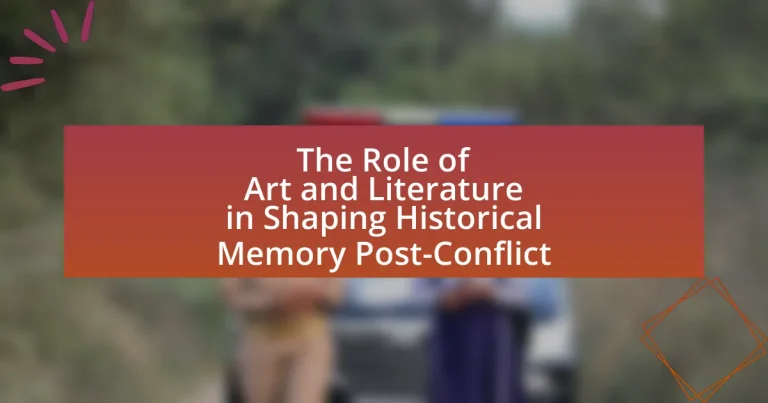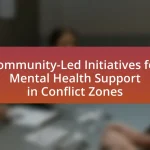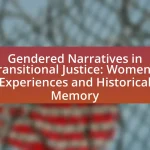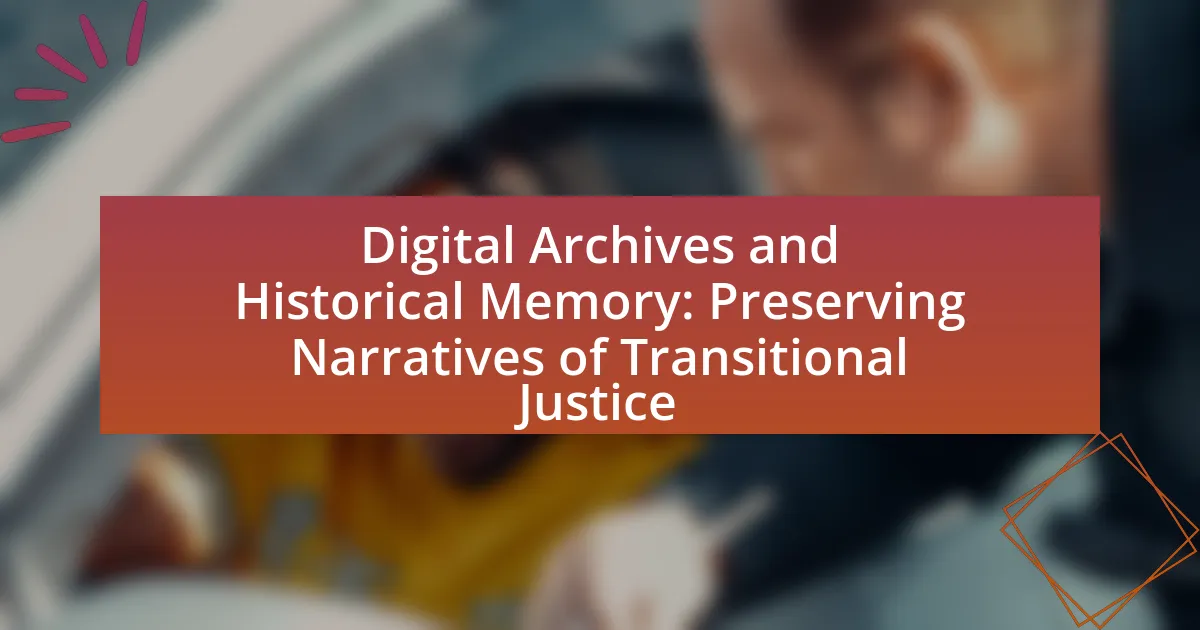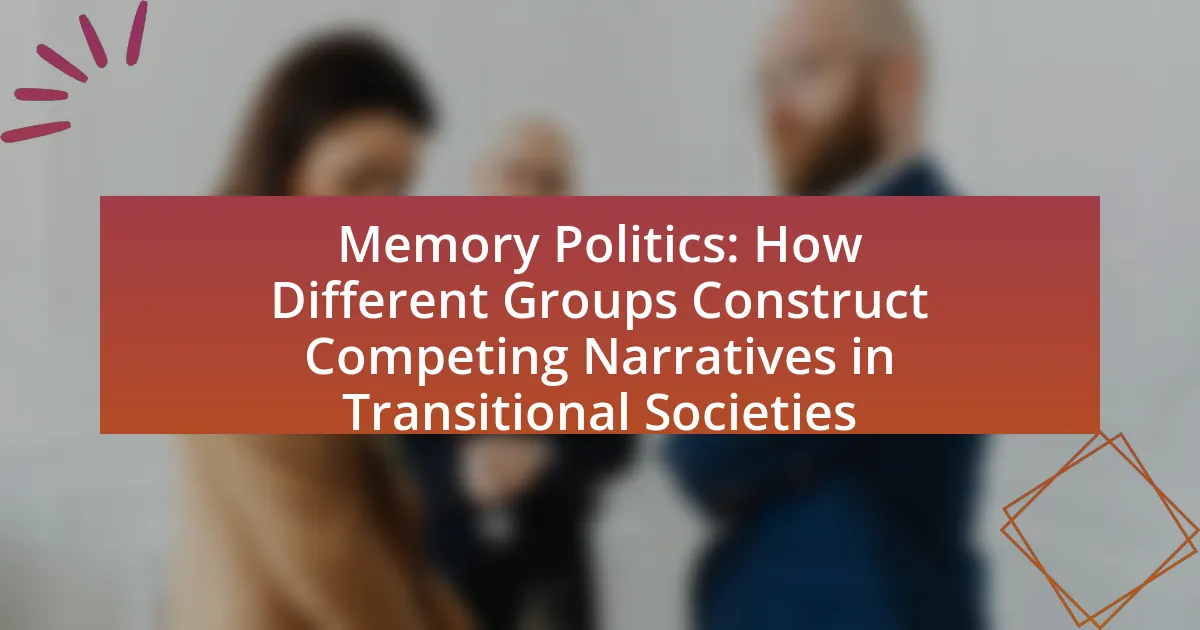The article examines the significant role of art and literature in shaping historical memory in post-conflict societies. It highlights how these forms of expression serve as vehicles for collective memory, allowing communities to process trauma, commemorate losses, and foster dialogue about their past. Key elements influencing historical memory include narrative structure, emotional resonance, and the representation of marginalized voices. The article also discusses how different artistic mediums convey post-conflict narratives, the importance of historical memory in reconciliation processes, and the challenges faced in utilizing art and literature for dialogue in post-conflict settings. Notable examples and themes prevalent in post-conflict art and literature are also explored, emphasizing their impact on identity formation and societal healing.
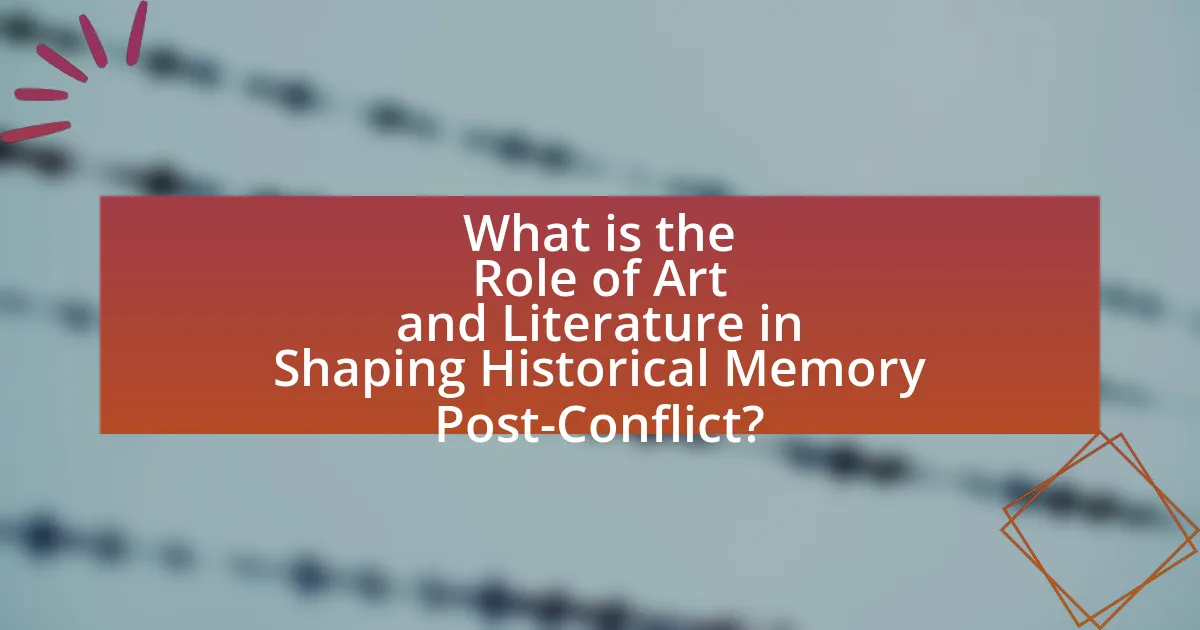
What is the Role of Art and Literature in Shaping Historical Memory Post-Conflict?
Art and literature play a crucial role in shaping historical memory post-conflict by providing narratives that reflect, interpret, and critique the experiences of individuals and communities affected by war. These forms of expression serve as vehicles for collective memory, allowing societies to process trauma, commemorate losses, and foster dialogue about the past. For instance, works like “The Things They Carried” by Tim O’Brien illustrate the psychological impact of the Vietnam War, while post-war literature from countries like Bosnia and Rwanda often addresses themes of reconciliation and identity. Such artistic representations not only preserve memories but also influence public perception and understanding of historical events, as seen in the impact of memorials and literature on the collective consciousness of nations recovering from conflict.
How do art and literature contribute to collective memory in post-conflict societies?
Art and literature contribute to collective memory in post-conflict societies by serving as mediums for expression, reflection, and healing. These forms of creative expression allow individuals and communities to process trauma, articulate experiences, and preserve narratives that might otherwise be forgotten. For instance, novels like “The Kite Runner” by Khaled Hosseini and artworks such as the “Memorial to the Murdered Jews of Europe” in Berlin provide platforms for remembering and confronting past atrocities, fostering a shared understanding of history. Research indicates that storytelling and artistic representation can facilitate dialogue and reconciliation, as seen in initiatives like the Truth and Reconciliation Commission in South Africa, where art was used to document and share personal stories of the apartheid era. Thus, art and literature play a crucial role in shaping and sustaining collective memory in the aftermath of conflict.
What are the key elements of art and literature that influence historical memory?
The key elements of art and literature that influence historical memory include narrative structure, symbolism, emotional resonance, and representation of marginalized voices. Narrative structure shapes how events are framed and understood, as seen in novels like “The Things They Carried” by Tim O’Brien, which uses storytelling to convey the complexities of the Vietnam War. Symbolism in visual art, such as Picasso’s “Guernica,” evokes powerful emotional responses and encapsulates the horrors of conflict, thereby embedding those experiences in collective memory. Emotional resonance is crucial, as works that evoke empathy, like Elie Wiesel’s “Night,” create lasting impressions that shape perceptions of historical events. Lastly, the representation of marginalized voices, as exemplified by the works of authors like Chimamanda Ngozi Adichie, ensures that diverse perspectives are included in the historical narrative, influencing how history is remembered and understood. These elements collectively contribute to the formation and evolution of historical memory in post-conflict societies.
How do different forms of art and literature convey post-conflict narratives?
Different forms of art and literature convey post-conflict narratives by providing emotional depth, personal perspectives, and cultural reflections that help societies process trauma and rebuild identity. Visual art, such as paintings and installations, often captures the visceral impact of conflict, allowing viewers to engage with the emotional landscape of war and its aftermath. For example, the works of artists like Ai Weiwei address themes of displacement and human rights, prompting public discourse on the consequences of conflict.
Literature, including novels, poetry, and memoirs, offers intimate accounts of individual experiences during and after conflict, fostering empathy and understanding. Notable works like “The Things They Carried” by Tim O’Brien illustrate the psychological burdens carried by soldiers, while Khaled Hosseini’s “The Kite Runner” explores themes of redemption and the lasting effects of war on personal relationships.
Moreover, theater and film serve as powerful mediums for storytelling, often dramatizing historical events and personal narratives to engage audiences emotionally. Productions like “The Vagina Monologues” have highlighted the experiences of women in conflict zones, raising awareness about gender-based violence in post-conflict societies.
These artistic expressions not only document historical events but also challenge dominant narratives, allowing marginalized voices to be heard and contributing to a collective memory that shapes societal healing and reconciliation.
Why is historical memory important in post-conflict contexts?
Historical memory is crucial in post-conflict contexts because it helps societies process trauma and fosters reconciliation. By acknowledging past atrocities and collective experiences, communities can build a shared understanding that promotes healing and prevents the recurrence of violence. For instance, the Truth and Reconciliation Commission in South Africa highlighted the importance of documenting historical injustices to facilitate dialogue and healing among divided groups. This process not only validates the experiences of victims but also encourages accountability and the establishment of a more just society.
What impact does historical memory have on reconciliation processes?
Historical memory significantly influences reconciliation processes by shaping collective identities and narratives. When communities remember past conflicts, the way they interpret these events can either foster understanding and healing or perpetuate division and resentment. For instance, in post-apartheid South Africa, the Truth and Reconciliation Commission utilized historical memory to address grievances and promote national unity, demonstrating that a shared understanding of the past can facilitate dialogue and forgiveness. Conversely, in regions where historical memory is contested, such as in the former Yugoslavia, differing narratives can hinder reconciliation efforts, leading to ongoing tensions. Thus, the impact of historical memory on reconciliation is profound, as it can either bridge divides or deepen them, depending on how the past is collectively remembered and represented.
How does historical memory shape identity in post-conflict societies?
Historical memory shapes identity in post-conflict societies by influencing collective narratives and individual perceptions of the past. In these societies, shared memories of conflict, trauma, and resilience often become integral to the community’s identity, fostering a sense of belonging and continuity. For instance, in Rwanda, the collective memory of the 1994 genocide has been crucial in shaping national identity and reconciliation efforts, as seen in the establishment of memorials and the promotion of narratives that emphasize unity and healing. This process is further reinforced by art and literature, which serve as mediums for expressing and preserving these memories, thus solidifying their impact on identity formation.
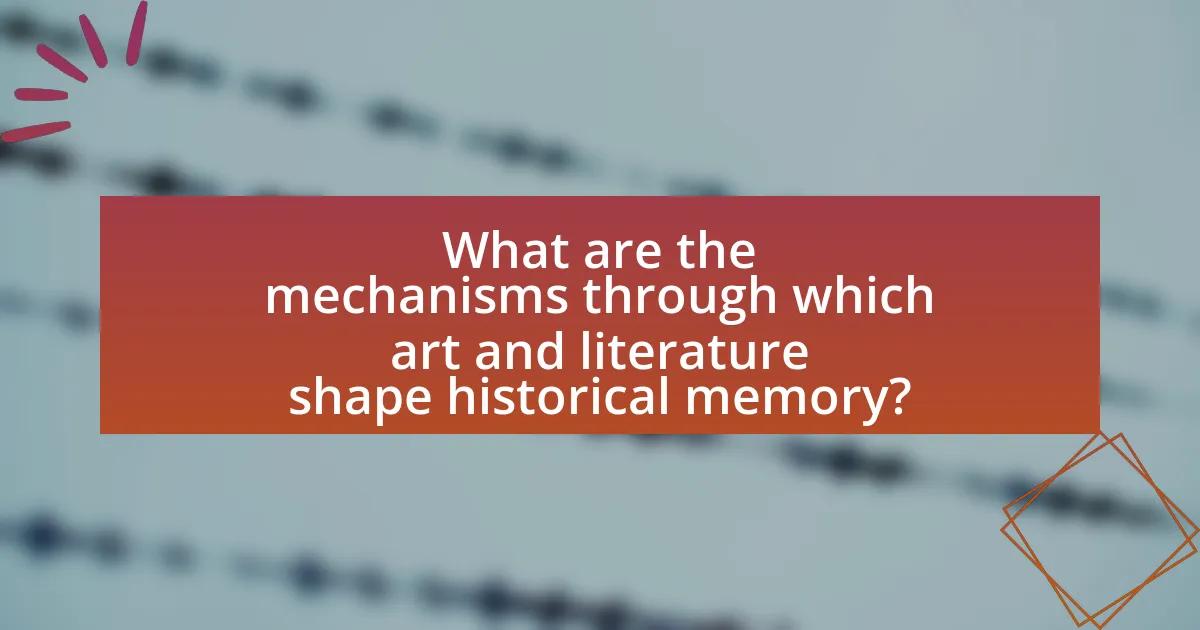
What are the mechanisms through which art and literature shape historical memory?
Art and literature shape historical memory through mechanisms such as narrative construction, emotional engagement, and cultural representation. Narrative construction allows artists and writers to frame historical events in specific ways, influencing how audiences perceive and remember those events. For instance, novels like “The Things They Carried” by Tim O’Brien provide personal perspectives on the Vietnam War, shaping collective memory by emphasizing individual experiences over mere facts. Emotional engagement is achieved through storytelling techniques that evoke empathy, making historical events more relatable and memorable. For example, the use of poetry during the Holocaust, such as the works of Paul Celan, captures the emotional weight of trauma, ensuring that the memory of such events persists. Cultural representation in art and literature also plays a crucial role; visual art, like Picasso’s “Guernica,” serves as a powerful political statement that memorializes the suffering caused by war, thereby embedding these memories into the cultural consciousness. These mechanisms collectively ensure that art and literature not only reflect historical realities but also actively shape how societies remember and interpret their pasts.
How do artistic expressions reflect the experiences of conflict?
Artistic expressions reflect the experiences of conflict by capturing the emotional and psychological impacts of war and violence. Through mediums such as painting, literature, music, and film, artists convey personal and collective narratives that illustrate the trauma, loss, and resilience associated with conflict. For instance, the works of artists like Pablo Picasso, particularly in “Guernica,” depict the horrors of the Spanish Civil War, serving as a powerful commentary on the devastation of conflict. Similarly, literature such as “The Things They Carried” by Tim O’Brien explores the complexities of soldiers’ experiences during the Vietnam War, highlighting themes of memory and trauma. These artistic representations not only document historical events but also foster empathy and understanding, allowing audiences to engage with the emotional realities of those affected by conflict.
What role do personal narratives play in artistic representations of conflict?
Personal narratives serve as crucial elements in artistic representations of conflict by providing intimate, subjective experiences that humanize broader historical events. These narratives allow artists to convey the emotional and psychological impacts of conflict, making abstract concepts more relatable and accessible to audiences. For instance, works like “The Things They Carried” by Tim O’Brien illustrate how personal stories can encapsulate the complexities of war, blending fact and fiction to evoke empathy and understanding. This approach not only preserves individual memories but also contributes to collective historical memory, influencing how societies remember and interpret past conflicts.
How do visual arts and literature differ in their portrayal of historical events?
Visual arts and literature differ significantly in their portrayal of historical events through their mediums and methods of expression. Visual arts, such as paintings and sculptures, often capture a moment in time, conveying emotions and perspectives through imagery, color, and form, which can evoke immediate emotional responses. For example, Pablo Picasso’s “Guernica” powerfully represents the horrors of war through abstract forms and stark contrasts, allowing viewers to interpret the chaos and suffering of the Spanish Civil War.
In contrast, literature employs narrative techniques, character development, and detailed descriptions to explore historical events over time, providing context and depth. Works like “The Book Thief” by Markus Zusak offer insights into the human experience during World War II through the eyes of a young girl, allowing readers to engage with the complexities of morality and survival.
Thus, while visual arts provide an instantaneous emotional impact through imagery, literature offers a more nuanced exploration of historical events through storytelling and character perspectives.
In what ways do art and literature facilitate dialogue about the past?
Art and literature facilitate dialogue about the past by providing platforms for reflection, interpretation, and emotional engagement with historical events. Through various forms such as novels, paintings, and poetry, creators express personal and collective experiences, allowing audiences to connect with different perspectives on history. For instance, works like “The Things They Carried” by Tim O’Brien explore the Vietnam War’s impact, prompting discussions about trauma and memory. Additionally, art installations, such as the “Memorial to the Murdered Jews of Europe” in Berlin, evoke emotional responses that encourage public discourse on the Holocaust. These mediums not only preserve memories but also challenge dominant narratives, fostering critical conversations about historical injustices and their implications for contemporary society.
How can literature serve as a platform for marginalized voices in post-conflict societies?
Literature serves as a platform for marginalized voices in post-conflict societies by providing a medium for expression, healing, and the documentation of experiences that are often overlooked. Through narratives, poetry, and essays, authors from marginalized communities can articulate their struggles, perspectives, and resilience, thereby fostering understanding and empathy among broader audiences. For instance, works like “The Kite Runner” by Khaled Hosseini highlight the experiences of Afghan people during and after conflict, allowing readers to engage with their stories on a personal level. This representation not only validates the voices of those affected but also contributes to the collective historical memory, ensuring that diverse experiences are acknowledged and remembered in the context of societal healing and reconciliation.
What are the challenges of using art and literature for dialogue in post-conflict settings?
The challenges of using art and literature for dialogue in post-conflict settings include the risk of misinterpretation, cultural sensitivities, and the potential for triggering trauma. Misinterpretation occurs when audiences perceive artistic expressions differently than intended, leading to misunderstandings that can exacerbate tensions. Cultural sensitivities arise as art and literature may reflect specific narratives that resonate with some groups while alienating others, complicating the dialogue process. Additionally, the emotional weight of traumatic experiences can be reactivated through artistic representations, hindering open communication and healing. These challenges highlight the complexity of employing art and literature as tools for dialogue in contexts marked by conflict and division.
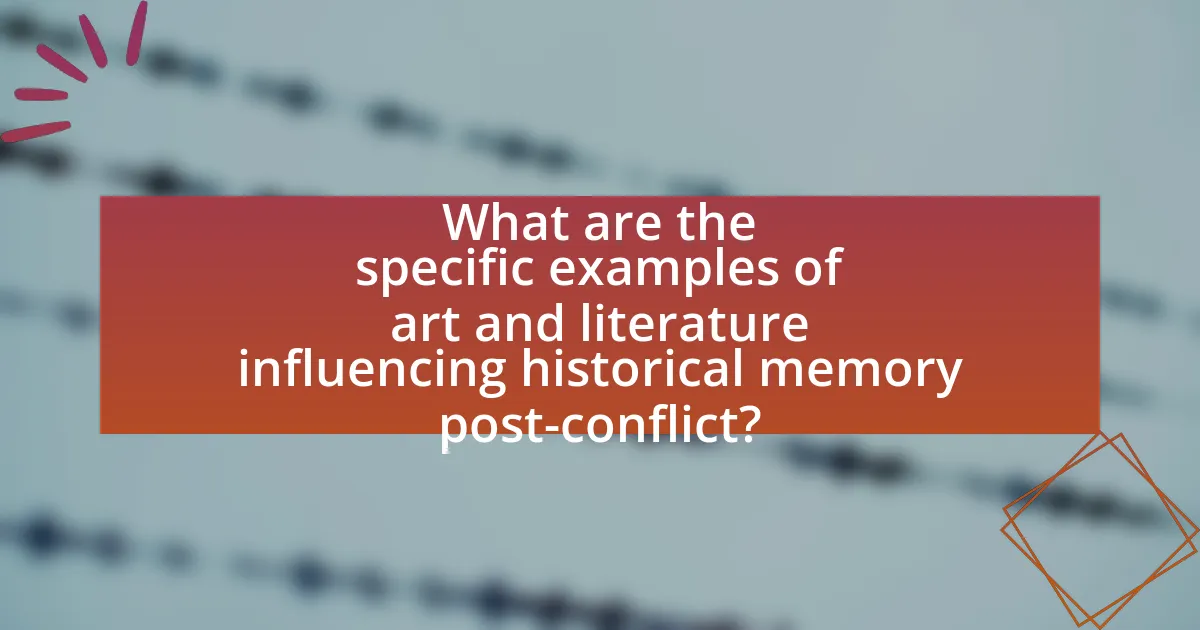
What are the specific examples of art and literature influencing historical memory post-conflict?
Art and literature significantly influence historical memory post-conflict through various notable examples. One prominent instance is the novel “The Things They Carried” by Tim O’Brien, which explores the Vietnam War’s emotional and psychological impacts, shaping collective memory by personalizing the experiences of soldiers. Another example is the mural art in Northern Ireland, particularly in Belfast, where murals depict the Troubles, serving as visual narratives that influence public perception and memory of the conflict. Additionally, the play “The Vagina Monologues” by Eve Ensler has been used in post-conflict settings like the Democratic Republic of Congo to address sexual violence, thereby influencing societal memory and awareness of the atrocities faced by women during war. These examples illustrate how art and literature serve as powerful tools in shaping and preserving historical memory after conflicts.
What notable works have emerged from post-conflict societies?
Notable works that have emerged from post-conflict societies include “The Kite Runner” by Khaled Hosseini, which explores the impact of the Afghan conflict on personal relationships and national identity. Additionally, “A Long Way Gone” by Ishmael Beah provides a harrowing account of child soldiers in Sierra Leone, highlighting the psychological scars of war. These works serve as critical reflections on the human experience in the aftermath of conflict, contributing to the broader discourse on historical memory and reconciliation.
How have these works been received by the public and critics?
The works addressing the role of art and literature in shaping historical memory post-conflict have generally been well-received by both the public and critics. Critics often praise these works for their ability to evoke emotional responses and provoke critical discussions about collective memory and identity. For instance, studies have shown that literature and art can significantly influence public perception of historical events, as evidenced by the impact of novels and visual art in post-war societies like Bosnia and Rwanda, where they have facilitated healing and reconciliation. Public reception tends to reflect a mix of appreciation for the artistic merit and the relevance of the themes presented, with many audiences finding personal connections to the narratives that resonate with their experiences of conflict and recovery.
What themes are prevalent in post-conflict literature and art?
Prevalent themes in post-conflict literature and art include trauma, memory, identity, and reconciliation. Trauma is often depicted through personal narratives that explore the psychological impact of conflict on individuals and communities. Memory plays a crucial role as artists and writers seek to document experiences and preserve collective histories, often challenging dominant narratives. Identity is frequently examined, as individuals grapple with the effects of conflict on their sense of self and belonging. Reconciliation emerges as a theme, highlighting efforts to heal divisions and foster understanding among conflicting parties. These themes are supported by numerous works, such as “The Things They Carried” by Tim O’Brien, which illustrates trauma and memory, and “A Long Way Gone” by Ishmael Beah, which addresses identity and reconciliation in the context of civil war.
How do different cultures approach the role of art and literature in shaping memory?
Different cultures utilize art and literature as vital tools for shaping memory, often reflecting their unique historical experiences and collective identities. For instance, in post-apartheid South Africa, literature and visual arts have been instrumental in addressing the trauma of the past, with works like “Long Walk to Freedom” by Nelson Mandela serving to memorialize struggles and foster reconciliation. Similarly, in Japan, the literary genre of “I-novel” has been used to explore personal and collective memories of wartime experiences, emphasizing individual narratives within the broader context of national history. These cultural approaches demonstrate that art and literature not only preserve memories but also facilitate dialogue and healing in societies recovering from conflict.
What cultural factors influence the creation of post-conflict art and literature?
Cultural factors that influence the creation of post-conflict art and literature include collective memory, identity reconstruction, and societal healing. Collective memory shapes how communities remember and interpret their experiences during conflict, often serving as a foundation for artistic expression. For instance, in post-apartheid South Africa, artists and writers have drawn upon shared memories of struggle and resilience to create works that reflect the nation’s journey toward reconciliation. Identity reconstruction is another critical factor, as individuals and communities seek to redefine themselves in the aftermath of conflict, often leading to the exploration of themes such as loss, trauma, and hope in their creative outputs. Additionally, societal healing plays a significant role; art and literature can facilitate dialogue and understanding, helping societies process their experiences and move forward. The Truth and Reconciliation Commission in South Africa exemplifies this, as it encouraged artistic expressions that contributed to national healing and unity.
How do global perspectives on post-conflict narratives differ?
Global perspectives on post-conflict narratives differ significantly based on cultural, historical, and political contexts. For instance, in Western societies, narratives often emphasize reconciliation and healing, focusing on individual stories of trauma and recovery, as seen in literature like “The Things They Carried” by Tim O’Brien, which explores the psychological impacts of war. Conversely, in regions like the Middle East, narratives may center on collective memory and resistance, reflecting ongoing struggles and the need for justice, as illustrated in works like “The Kite Runner” by Khaled Hosseini, which addresses the complexities of identity and conflict. These differences highlight how art and literature serve as tools for shaping historical memory, influenced by the unique experiences and values of each society.
What best practices can be adopted for utilizing art and literature in post-conflict memory work?
Best practices for utilizing art and literature in post-conflict memory work include fostering inclusive participation, promoting diverse narratives, and ensuring accessibility. Inclusive participation allows various community members, including marginalized voices, to contribute, which enhances the authenticity of the memory work. Promoting diverse narratives helps to capture the complexity of experiences and prevents the dominance of a single perspective, as seen in initiatives like the Truth and Reconciliation Commission in South Africa, which utilized storytelling to address multiple viewpoints. Ensuring accessibility, through formats like public installations or translated literature, allows broader engagement and understanding, exemplified by projects such as the “Memory Project,” which shares stories of conflict through various artistic mediums. These practices collectively contribute to a more comprehensive and empathetic understanding of post-conflict realities.
How can communities effectively engage with art and literature to foster healing?
Communities can effectively engage with art and literature to foster healing by creating inclusive platforms for expression and dialogue. These platforms, such as community art projects, literary workshops, and public readings, allow individuals to share their experiences and emotions related to trauma, thereby promoting collective healing. Research indicates that art therapy and narrative practices can significantly reduce symptoms of PTSD and enhance emotional resilience, as evidenced by studies conducted by the American Art Therapy Association, which highlight the therapeutic benefits of creative expression in post-conflict settings. By facilitating these engagements, communities not only validate individual experiences but also build a shared narrative that contributes to social cohesion and recovery.
What strategies can be implemented to promote inclusive narratives in post-conflict art and literature?
To promote inclusive narratives in post-conflict art and literature, strategies such as collaborative storytelling, representation of diverse voices, and community engagement should be implemented. Collaborative storytelling involves bringing together individuals from various backgrounds to share their experiences, fostering a sense of shared history and understanding. Representation of diverse voices ensures that marginalized groups are included in the narrative, which can be achieved through targeted outreach and support for underrepresented artists and writers. Community engagement can be facilitated through workshops and public forums that encourage dialogue and participation, allowing communities to collectively shape their narratives. These strategies have been shown to enhance social cohesion and healing in post-conflict societies, as evidenced by initiatives like the “Truth and Reconciliation Commission” in South Africa, which utilized storytelling to address historical injustices.
